France - Stade de France
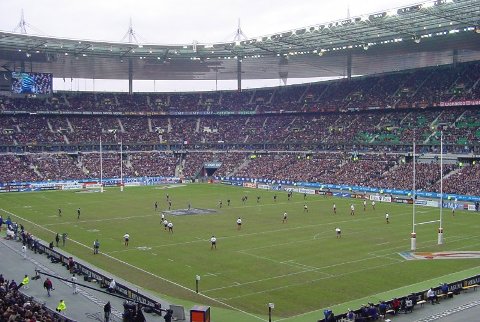
France have been competing in international rugby union fixtures since 1906, joining the then Five Nations annual tournament in 1910. It wasn't however until 1959 that France first won a Five Nations title, with a draw against England and home victories over Scotland and Wales getting them over the line. In total the French have won the Five/Six Nations title on 17 occasions, with 9 Grand Slams. 'Les Bleus' have also competed in every Rugby World Cup so far, reaching the final three times in 1987 (vs New Zealand), 1999 (Australia) and and 2011 (New Zealand) without yet winning the tournament.
Ground Information Back to Top ^
The Stade de France has been the national stadium for the
majority
of both French rugby union and football fixtures since opening in 1998,
and also hosts the domestic cup finals in both sports. Local club sides
Racing Metro and Stade Francais have moved high-profile fixtures to
this venue, whilst the opening fixture and final of the Rugby World Cup
2007 were also played at the ground.
The 81,000 seater
stadium is situated in the rather unglamorous Northern Parisian suburb
of Saint-Denis but within easy access of the City. The Stade de France
is also able to host athletics events, but thankfully the stands can
slide in and out meaning for rugby fixtures there is no running track
separating fans from the action

There
are three tiers of seating on every side, with the priciest seats
usually in the lower and middle tiers on the halfway line (East
&
West Stands) and the cheapest in the upper and lower tiers behind the
posts (North and South). Whilst every seat is technically covered from
the elements, if you are seated in the front tier and the wind is
against you there is more than a slight chance of getting wet. Two
large screens are located at either end of the pitch, though remarkably
for such a modern stadium the pitch lacks under-soil heating which led
to controversy in 2012 when a Six Nations match between Ireland and
France was postponed at the last moment with the stadium full of
supporters.
The atmosphere at matches is variable to say the
least, as the French fans have a tendency to boo their own side when
things aren't going their way, or resort to mexican waves if the match
isn't particularly inspiring. Despite such flakiness, if France are
appeasing the masses then the chants of 'Allez les Bleus' around the
ground can be immense.
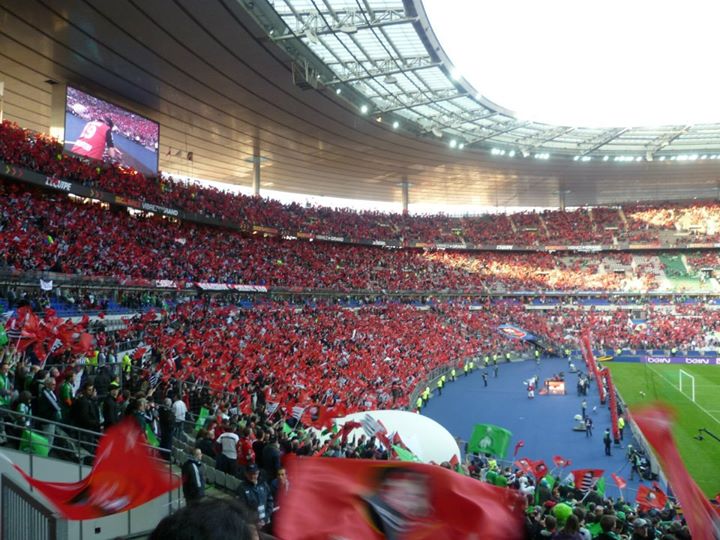
The North Stand
Getting There Back to Top ^
The Stade de France was designed and built with public transport in mind, so if you can avoid driving it is advisable to do so as parking is limited in the vicinity of the stadium and there isn't usually official parking available for rugby fixtures. In any case, it takes a certain combination of bravery and stupidity to take on Parisian drivers at their own game!
By Train (to Paris)
Paris
is a focal point of the high-speed rail network in France and Western
Europe. The majority of international services arrive at the Gare du
Nord, including those from London, Brussels, Holland and Germany.
Direct trains then operate from the Gare du Nord to the Stade de France.
From
within France, the majority of high-speed services operate to the Gare
Montparnasse, whilst slower services arrive at either the Gare
d'Auterlitz (from central/SW France) or the Gare de Lyon (from
South/Eastern France). Use the Metro / RER services listed below to get
to the stadium.
By Train / Metro (to the Ground)
The
Stade de France is well-served by rail. The suburban rail network in
Paris (known as the RER) has two lines serving the 'Stade de France -
Saint Denis' station - RER B and RER D, and is the quickest way to get
to the ground. Both lines depart from the Gare du Nord (5 minutes
journey time), Châtelet-Les Halles (10 minutes) and Gare de Lyon (15
minutes) in the City Centre, and run regularly before and after
matches.
The Saint-Denis branch of Line 13 on the Paris
Metro also serves the 'Saint-Denis-Porte de Paris' station close to the
stadium and runs to Gare Saint-Lazare (15 minutes), Invalides (20
minutes) and Gare Montparnasse (25 minutes) amongst others.
You can view a useful map of both the RER and Metro network here.
One
of the main downsides to the Stade de France is that when the stadium
is busy, you may have to queue for up to an hour to get into the
stations outside the stadium to get back to Paris. Your best bet is to
either leg it when the match ends and beat the crowd, or try not to
plan anything too soon afterwards. There are plenty of vendors around
so you can enjoy a beer outside and digest the game with fellow
supporters whilst the crowds die down.
Paris is served by three
airports;
Charles de Gaulle
Situated
in the northern suburbs, Charles de Gaulle is the closest airport to
the Stade de France and also the largest airport in Paris. Flights
operate to a wide range of rugby-friendly destinations including
Belfast (City and International), Birmingham, Cardiff, Cork, Dublin,
Edinburgh, London (Heathrow, Luton and Stansted), Manchester and
Toulouse. Major airlines based here include Air France, Easyjet, Aer
Lingus and Flybe. A word of warning however - the airport is subdivided
into loads of terminals, so make sure you know in advance which part
you need!
The airport is served by direct trains (RER B) to
the Stade de France and the city centre. If you are willing to risk the
traffic on the roads, there is also a direct bus service operated by
Roissybus from the airport to Paris.
Orly
Orly
Airport is situated in the southern suburbs, where the RER train line B
provides connections to central Paris and onwards to the Stade de
France. Scheduled flights operate to destinations across France in
addition to London (City and Heathrow), Milan (Linate), Naples, Pisa,
Rome (Fiumicino), Southampton and Venice (Marco Polo).
Beauvais
Beauvais
is the Parisian choice for low cost carrier Ryanair, and as expected it
is also the furthest away from the city (around 80km!). Destinations
include Dublin, Edinburgh, Glasgow (Prestwick), Venice (Treviso), Rome
(Ciampino) and Marseille.
To get into Paris, take the
shuttle bus to Porte Maillot station (journey time around 1h 15
minutes) where the Paris Metro or RER will take you the rest of the way
into town. Alternatively you can take a taxi around 15 minutes to the
train station in Beauvais town centre, where services operate to the
Gare du Nord, taking around an hour.
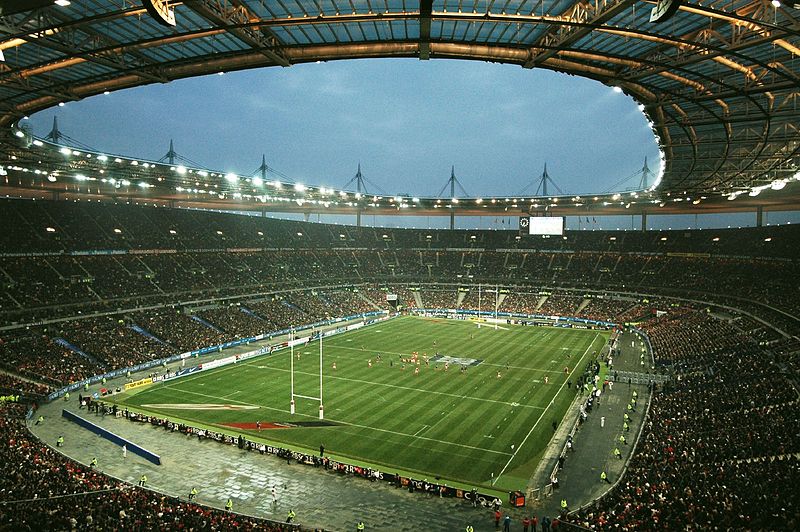
Stade de France during an
evening fixture
Image: Thomas Faivre-Duboz
Drinking Back to Top ^
Popular spots centre around the Gare du Nord and Châtelet areas in close proximity to rail connections to the ground. Below are a few recommendations for where to drink, though expect to have to shop around for happy hours if you are price sensitive, as drinks don't tend to come cheap in this city.
- The centrally-located (nearest Métro Opéra) Kitty O'Sheas is a good rugby pub that will definitely be busy on Six Nations weekends.
- The Eden Park Pub on Rue Princesse is a good bet in Paris to catch Heineken Cup, Top14 or Six Nations matches. Situated within walking distance of Mabillon, St Sulpice and St Germain des pres Métro stations.
- The excellently-named Frog and Rosbif and The Thistle on Rue St Denis tick the English and Scottish pub boxes, and will also show matches live.
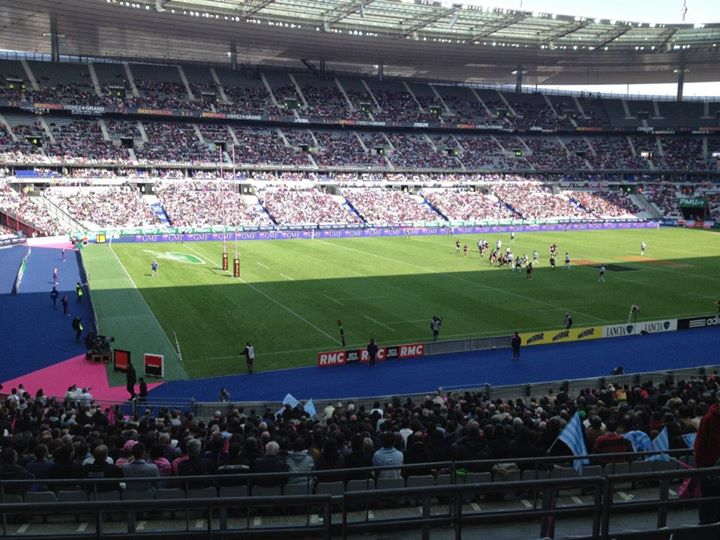
Eating Back to Top ^
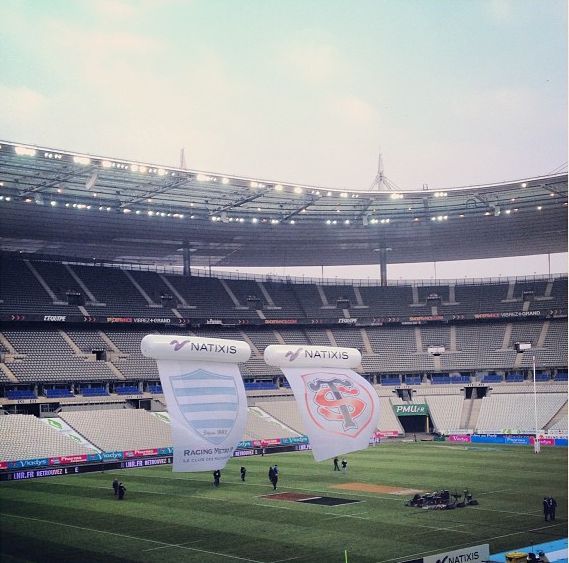
Sleeping Back to Top ^
The City Centre of Paris provides every kind of accommodation you could imagine from dorm rooms in hostels to luxury hotels. If you need to stay near to the stadium here are several options;- The Novotel (literally opposite the stadium)
Make a Trip of It Back to Top ^
There isn't enough room here to detail all the sights and attractions that make Paris one of the most visited cities in the world. Try Wikitravel for details and recommendations on what to see and do during your stay.Key Information
- Capacity
81,338 - Address
Stade de France
Zac de Cornillion Nord
Saint-Denis
Paris - Website
www.ffr.fr
Disabled Supporters
- Disabled access to all stands within the stadium is good and there are around 1000 seats for wheelchair users.
Ground Facts
- Despite being a relatively modern stadium, the Stade de
France
pitch lacks undersoil heating. This led to controversy in 2012 when a
Six Nations match between France and Ireland was postponed at the last
minute with the stadium full of supporters.
- In the future, it is likely that French rugby will no longer use the Stade de France, as the FFR have indicated a preference to construct their own stadium in the South of Paris to avoid problems with scheduling and funding.
Twos-Up
- Paris is home to two sides who play in the Top 14 league, Racing Metro and Stade Francais. As the domestic league often continues during international weekends, there is a good chance you could combine an international fixture with a club game.
No Alcohol? Mais Non!
- A word of caution for booze fans - not only do all drinks in the Stade de France come at an inflated price, they are also alcohol-free including the beer! There are however loads of pop-up stands outside the ground where you can grab a pint, at typical Parisian prices.
Add Your Information
- Got something to add? Spotted a mistake? The Rugby Ground
Guide is dependent on your input to make it work
- You can submit information or images here.
